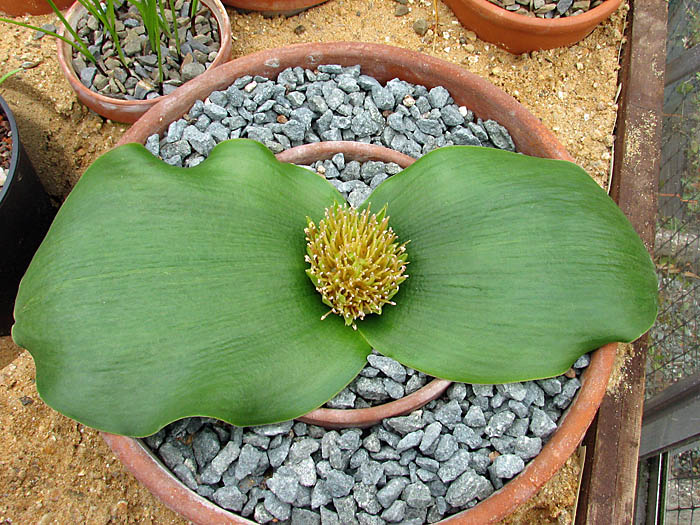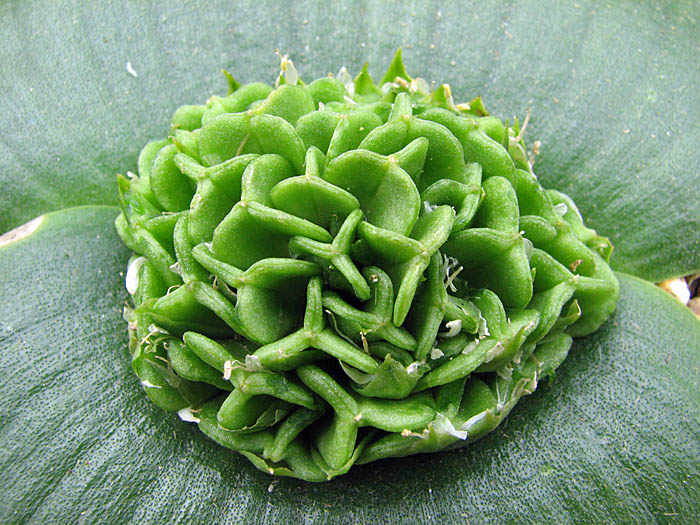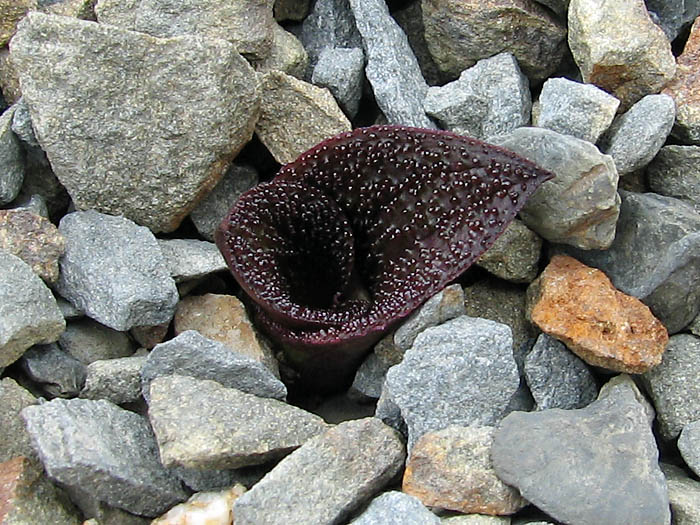|
Wisley's Alpine Log
By Paul Cumbleton
Log 8 8th Nov 2007
Massonia and Daubenya
These two genera of winter-growing bulbs from South Africa are absolute favourites of mine and I grow a great many at home as well as at Wisley. Their unusual forms, flowers and scent always provoke surprise and interest from visitors when we display them in the Alpine House. I thought it time I did some logs focussing on specific plants so I'm indulging myself with my own favourites and hoping what follows will encourage more of you to try these amazing plants. I'm going to deal with Massonia this week and then with Daubenya in the next log in two weeks time.
Massonia
The taxonomy of Massonia and Daubenya was revised in recent years after DNA work done by Alison van der Merwe. Gladly, for once, this seems to have clarified and simplified what was a confusing mess of names. For Massonia, there are now six recognised species: M. depressa, M. echinata, M. hirsuta, M. jasminiflora, M. pustulata and M. pygmaea. They all have just two leaves which usually lay flat or nearly so on the ground and which are often patterned, hairy or pustulate. The flowers emerge out of the centre of the pair of leaves and the long anther filaments are the most obvious parts. The flowers are often highly scented.

Massonia depressa
Massonia depressa, shown above, is the largest of the genus and the leaves of some forms can reach 25cm long. In this species the leaves are usually smooth and occasionally spotted. While most Massonias are pollinated by bees or butterflies, this one is really unusual. The flowers produce a lot of nectar and have a yeasty smell which attracts…Gerbils! …and other rodents. Various members of the Proteaceae family are known to be pollinated by rodents, but M. depressa is unique in the bulb world for using this method of pollination. You can read the scientific paper that proved this - along with cute pictures of Gerbils doing the business…at http://www.amjbot.org/cgi/content/full/88/10/1768?ck=nck
The flowers of M. depressa are to my mind the least attractive of the six species, usually an off-white or sometimes darker colours, but the leaves can be impressive. This form (pictured still emerging in autumn) has a nice red edge to the leaves:
.jpg)
Massonia depressa, red edged leaf
The fruits containing the seeds can be decorative in their own right, especially in this species where they get quite large. The capsules are three-winged and each locule contains several seeds.

Massonia depressa with seed capsules
M. echinata is in flower right now and attracting attention in the Alpine House with its white flowers which are honey-scented. Like the previous species, it is widespread in the winter rainfall region of South Africa

Massonia echinata
Massonia hirsuta is much less common in cultivation here in the UK and the picture below is of the only one I have seen, here as young seedlings, in a private collection.

Massonia hirsuta
M. jasminiflora occurs further east than most other species, into the summer-rainfall area, but it still grows and flowers in the winter - except for a subspecies that occurs in the Black Mountains of Lesotho which grows and flowers in summer. This summer-growing form is the smallest of all the Massonias, but overall the species is quite variable in form. The flowers can be white to pink and the leaves pustulate or smooth, in varying shades of green and sometimes with reddish streaks. As its name suggests, the flowers have a scent like jasmine. I find the flowers the most attractive of the genus, especially in the following form:

Massonia jasminiflora
M. pustulata In its best forms, this can be a truly striking plant. Occasionally forms occur whose leaves are smooth or with few pustules, but more often they are covered in pustules providing a dramatic display.
.jpg)
Massonia pustulata (from Arniston)
The variation in the leaves includes their colour which can range from pale to dark green and with or without purple colouration. Here is a pale acid-green form from Loreisfontein:
.jpg)
Massonia pustulata (Loriesfontein)
Compare that with this form that has purple streaking:

Massonia pustulata
The above form is particularly striking as it first emerges, as at that time the leaf is entirely dark purple, with the green tones only developing later as the leaf expands:

Massonia pustulata (emerging purple)
M. pustulata flowers have the longest filaments of the six species which makes for a showy flower:

Massonia pustulata flower
M. pygmaea Finally is M. pygmaea, a species which often grows at high altitudes. Apart from the subspecies of M. jasminiflora mentioned above, this is the smallest Massonia species, individual leaves rarely attaining more than 6cm long. It is usually the first of the Massonias to flower, the blooms appearing in early to mid October, and it has already been and gone over here at Wisley.

Massonia pygmaea
The leaves are usually hairy as seen above, but some forms - often called ssp. kamiesbergensis - are smooth as pictured below. Note that this plant has produced three leaves, which happens sometimes with any of the species in this usually two-leaved genus.

Massonia pygmaea ssp. kamiesbergensis
In the next log I will deal with cultivation as well as looking at the Daubenyas. But before I sign off today I want to inform you all of an exciting event next year that the department is organising. This is our "Hepatica Spectacular", I would not normally consider advertising events in my log, but as this is an alpine thing organised specifically by the Alpine section I thought you would be interested. The event consists of two aspects:
Firstly, running from 8th to 16 March we plan to put on a special display of Hepaticas. We will empty the Alpine Display House of its usual mix of alpines and fill it entirely with Hepatica. Virtually our entire collection will be on display, which will include many of the choice Japanese cultivars as well as the European species.

Hepatica
Secondly, on March 15th 2008 we will have a day of lectures & demonstrations all about Hepaticas. This celebration of Hepatica will commence with a fascinating talk about these beautiful plants by John Massey of Ashwood Nurseries. Then Gunther Kleinhans, donator of Wisley's collection of Japanese Hepatica, will provide a unique insight into these stunning cultivars as well as the cultivation practices used by Japanese enthusiasts. He hopes to bring with him Kazuko Ishikawa, one of the Japanese professional growers, though her attendance is yet to be confirmed. After the lectures there will be a chance to see the special display of plants in the Alpine House, accompanied by the speakers.
The display of plants is free to all visitors to the garden. The day of lectures is a ticketed event and tickets must be booked in advance. To book tickets, phone the RHS on 0845 6121253 and quote event number 4313. Tickets cost £17 for RHS members and £24 for non-members. The cost includes a light lunch. Tickets can also be ordered by post from: Events Booking, RHS Membership Dept., PO Box 313, London, SW1P 2PE. Please enclose a cheque payable to "Royal Horticultural Society", your RHS Membership no. (if relevant) and daytime telephone no. Quote event code 4313 and the title of the event which is "Hepatica Spectacular" and state how many tickets you require.
Tickets should arrive within 10 days of receiving your order. Any problems, contact Customer Services on 0845 6121253
We hope many of you will come and join us for this celebration of all things Hepatica!
^ back to the top ^
|

